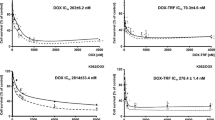Summary
3′-Deamino-3′-(4-morpholinyl)adriamycin (MRA) and 3′-deamino-3′(3-cyano-4-morpholinyl)adriamycin (MRA-CN) were compared with adriamycin (ADR) in ADR-sensitive (P388/S) and-resistant (P388/ADR) murine leukemia cell lines with respect to cytotoxicity and cellular accumulation. MRA is only two- to threefold more cytotoxic to P388/S in culture than ADR, whereas MRA-CN is 500-fold more cytotoxic than ADR to this cell line. Yet both MRA and MRA-CN retain their potency against P388/ADR in spite of a 150-fold decrease in potency for ADR. The observed noncross-resistance of both MRA and MRA-CN in P388/ADR correlates with their increased cellular uptake and retention relative to ADR and the inability of P388/ADR to exclude these analogs as readily as it does ADR. The decreased uptake of MRA and MRA-CN in P388/ADR relative to P388/S (1.5 to 2.0-fold), the increased efflux, and the ability of verapamil to enhance cellular uptake of these analogs in P388/ADR, as it does with ADR, all indicate that the mechanism of ADR-resistance effects ADR and the morpholino analogs in a similar manner but to far different extents. The potent cytotoxicity of MRA-CN appears to be related to strong cellular interactions of the drug with macromolecules that are characterized by its nonextraction from cells by chloroform: methanol or 10 M urea and may therefore represent covalent binding.
Similar content being viewed by others
References
Acton EM, Jensen RA, Peters JH (1982) Factors in the selection of new anthracyclines. In: Anthracycline antibiotics in chemotherapy. Martinus Nijhoff, The Hague, p 205
Acton EM, Tong GL, Mosher GW, Wolgemuth RL (1984) Intensely potent morpholinyl anthracyclines. J Med Chem 27: 638
Bachur NR, Moor AL, Bernstein JG, Liu A (1970) Tissue distribution and disposition of daunomycin (NSC-82151) in mice: fluorometric and isotopic methods. Cancer Chemother Rep 54: 89
Carter SK (1980) The clinical evaluations of analogs. III. Anthracyclines. Cancer Chemother Pharmacol 4: 5
Inaba M, Johnson RK (1978) Uptake and retention of adriamycin and daunorubicin by sensitive and anthracycline-resistant sublines of P388 leukemia. Biochem Pharmacol 27: 2123
Inaba M, Kobayashi H, Sakurai Y, Johnson RK (1979) Active efflux of daunorubicin and adriamycin in sensitive and resistant sublines of P388 leukemia. Cancer Res 39: 2200
Johnston JB, Glazer RI (1983) Cellular pharmacology of 3′-(4-morpholinyl) and 3′-(4-methoxy-1-piperidinyl) derivatives of 3′-deaminodaunorubicin in human colon carcinoma cells in vitro. Cancer Res 43: 1606
Johnston JB, Habernicht B, Acton EM, Glazer RI (1983) 3′-(3-cyano-4-morpholinyl)-3′-deaminoadriamycin: a new anthracycline with intense potency. Biochem Pharmacol 32: 3255
Lown JW, Joshua AV, Lee JS (1982) Molecular mechanisms of binding and single-strand scission of deoxyribonucleic acid by the antitumor antibiotics saframycins A and C. Biochemistry 21: 419
Menozzi M, Valentini L, Vannini E, Penco S, Arcamone F (1984) The interaction with DNA of a new class of anthracycline derivatives. 1st European Conference on Advances in Antitumor Agents, Milan, Italy
Mosher CW, Wu HY, Fujiwara AN, Acton EM (1982) Enhanced antitumor properties of 3′-(4-morpholinyl) and 3′-(4-methoxyl-1-piperidinyl) derivatives of 3′-deaminodaunorubicin. J Med Chem 25: 18
Ozols RF, Wilson JKV, Grotzinger KR, Young RC (1980) Cloning of human ovarian cancer cells in sofl agar from malignant effusions and peritoneal washings. Cancer Res 40: 2743
Peters JH, Gordon GR, Acton EM (1984) In vitro studies of a new intensely potent anthracycline. Proc Am Assoc Cancer Res 25: 293
Ramu A, Spanier R, Rahaminoff H, Fuks Z (1984) Restoration of doxorubicin responsiveness in doxorubicin-resistant P388 murine leukemia cells. Br J Cancer 50: 501
Siegfried JM, Burke TG, Tritton TR (1985) Cellular transport of anthracyclines by passive diffusion. Biochem Pharmacol 34: 593
Sikic BI, Eksam MN, Harker WG, Friend NF, Brown BW, Newman RA, Hacker MP, Acton EM (1985) Dissociation of antitumor potency from anthracycline cardiotoxicity and resistance in a doxorubicin analog. Science 228: 1544
Streeter DG, Acton EM, Filppi JA, Wolgemuth RL (1985) Structure-activity relationships for non-cross-resistance (NXR) of 3′-deamino-3′-(3-cyano-4-morpholinyl)doxorubicin (MRA-CN) and new analogs. Proc Am Assoc Cancer Res 26: 220
Streeter DG, Taylor DL, Peters JH, Acton EM (1984) Comparative cytotoxicities of various morpholinyl anthracyclines. Proc Am Assoc Cancer Res 25: 301
Streeter DG, Taylor DL, Peters JH, Acton EM (1985) Comparative cytotoxicities of various morpholinyl anthracyclines. Cancer Chemother Pharmacol 14: 160
Tsuruo T, Iida I, Yamashiro M, Tsukagoshi S, Sakurai Y (1982) Enhancement of vincristine- and adriamycin-induced cytotoxicity by verapamil in P388 leukemia and its sublines resistant to vincristine and adriamycin. Biochem Pharmacol 31: 3138
Westendorf J, Groth G, Steinheider G, Marquardt H (1985) Formation of DNA-adducts and induction of DNA-crosslinks and chromosomal aberrations by the new potent anthracycline antitumor antibiotics: morpholinodaunomycin, cyanomorpholinodaunomycin, and cyanomorpholinoadriamycin. Cell Biol Toxicol 1: 87
Westendorf J, Marquardt H, Marquardt H (1984) Structure-activity relationship of anthracycline-induced genotoxicity in vitro. Cancer Res 44: 5599
Yanovich S, Taub RN (1983) Differences in daunomycin retention in sensitive and resistant P388 leukemia cells as determined by digitized video fluorescence microscopy. Cancer Res 43: 4167
Young RC, Ozols RF, Meyers CE (1981) The anthracycline anticancer drugs. N Engl J Med 305: 135
Author information
Authors and Affiliations
Rights and permissions
About this article
Cite this article
Streeter, D.G., Johl, J.S., Gordon, G.R. et al. Uptake and retention of morpholinyl anthracyclines by adriamycin-sensitive and-resistant P388 cells. Cancer Chemother. Pharmacol. 16, 247–252 (1986). https://doi.org/10.1007/BF00293986
Received:
Accepted:
Issue Date:
DOI: https://doi.org/10.1007/BF00293986




